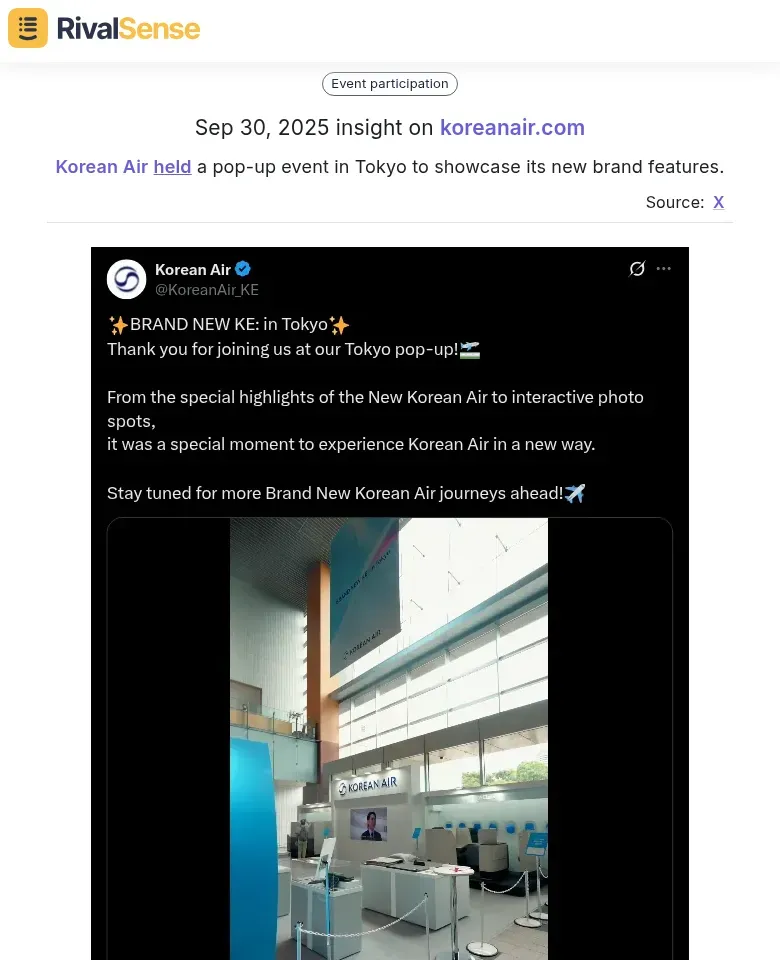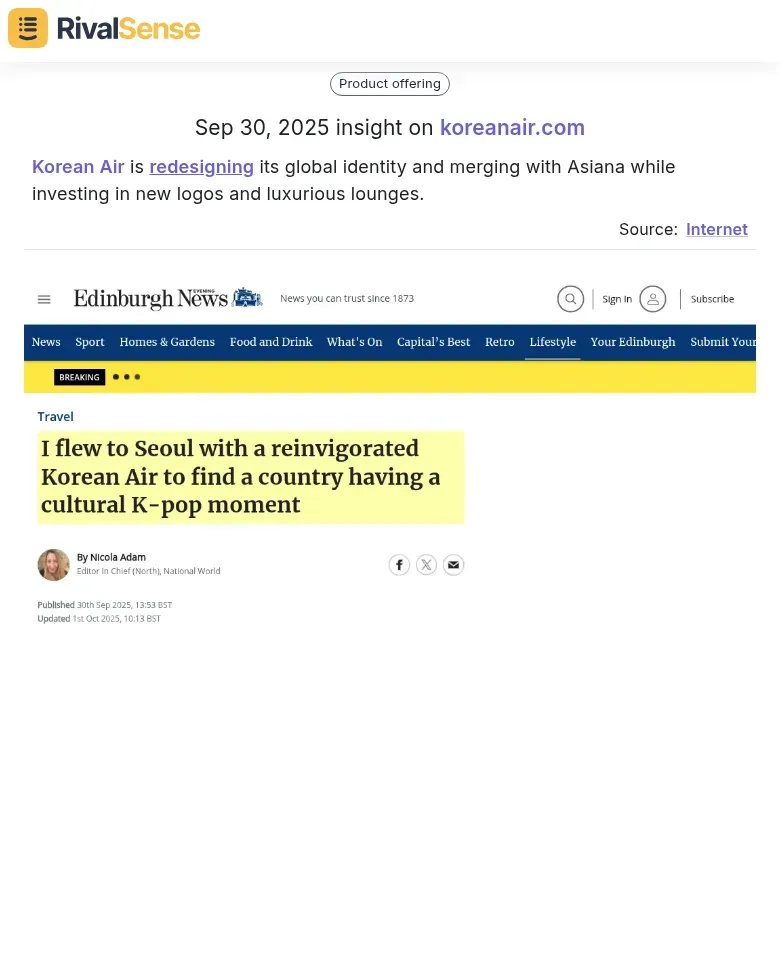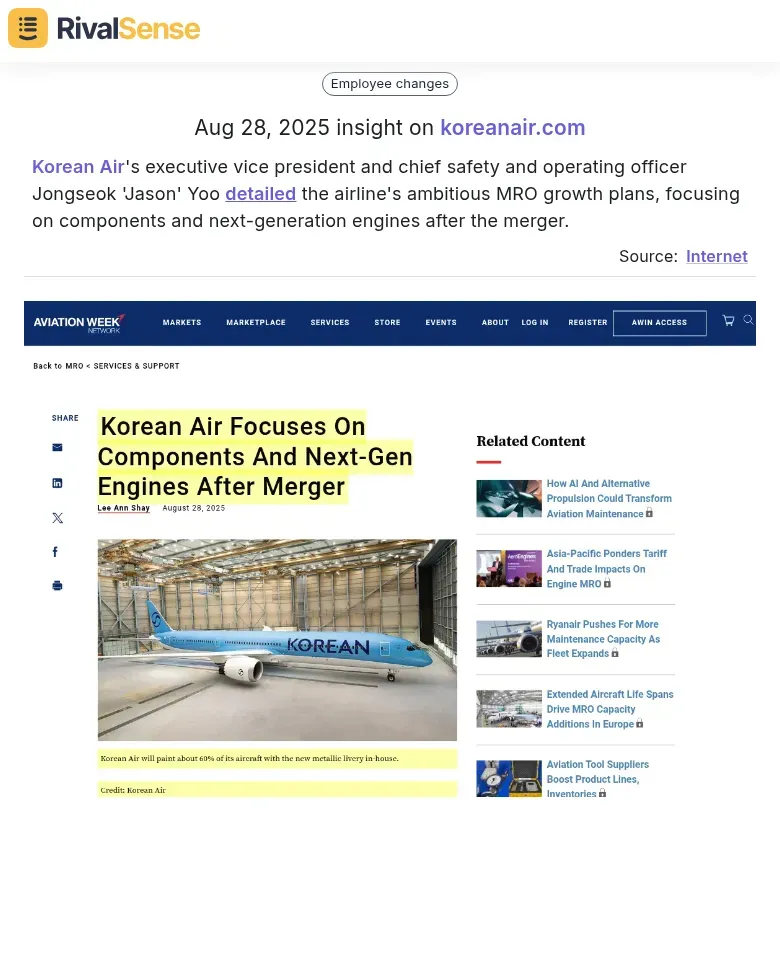Competitor Tracking Mastery: Real-World Lessons from Korean Air for B2B Leaders
In today's fast-paced business environment, staying ahead of competitors is crucial for sustained growth and market leadership. For B2B companies, tracking rivals' moves—from pricing shifts to strategic partnerships—provides actionable intelligence that fuels proactive decision-making. The airline industry, with its high stakes and rapid changes, offers valuable parallels; by examining how players like Korean Air monitor and respond to competition, business leaders can extract universal principles for their own strategies. This article delves into practical examples from Korean Air, highlighting how systematic competitor tracking enables organizations to anticipate market trends, optimize operations, and enhance customer experiences. We'll cover actionable steps, including regular analysis of competitor activities and benchmarking against industry standards, to help you build a robust competitive intelligence framework.
Brand Experience and Customer Engagement Strategies
Customer engagement is a cornerstone of brand loyalty and differentiation, especially in competitive markets where experiences drive purchasing decisions. Korean Air's innovative approaches, such as immersive pop-up events, demonstrate how direct interaction can elevate brand perception and foster emotional connections with audiences. For instance, Korean Air held a pop-up event in Tokyo to showcase its new brand features, engaging attendees with hands-on activities like seat trials and photo opportunities.  Tracking such experiential marketing efforts is invaluable for business strategy, as it reveals competitors' tactics for customer acquisition and retention, allowing you to adapt or counter similar initiatives in your industry.
Tracking such experiential marketing efforts is invaluable for business strategy, as it reveals competitors' tactics for customer acquisition and retention, allowing you to adapt or counter similar initiatives in your industry.
To replicate this success in your B2B context, consider these practical steps:
- 🎯 Plan targeted activations: Identify high-traffic venues or industry events to maximize visibility and engagement.
- ✨ Incorporate interactive elements: Use demos, workshops, or digital touchpoints to immerse participants and gather feedback.
- 📱 Leverage social media and digital channels: Encourage sharing with incentives like exclusive content or rewards to amplify reach.
- 📊 Measure impact systematically: Track metrics such as engagement rates, lead generation, and customer sentiment shifts using surveys and analytics tools.
By integrating these strategies, you can enhance customer loyalty and stay competitive in evolving markets.
Brand Identity and Merger Integration Insights
Rebranding and mergers are pivotal moments that can reshape market dynamics, requiring careful planning and execution to maintain competitiveness. Korean Air's merger with Asiana Airlines serves as a prime example of how strategic identity transformation can unify operations and reinforce brand values. Korean Air is redesigning its global identity and merging with Asiana while investing in new logos and luxurious lounges, signaling a commitment to luxury and reliability post-integration.  Monitoring such rebranding efforts is essential for business strategy, as it provides insights into competitors' positioning and helps identify opportunities to differentiate your own brand through visual and experiential elements.
Monitoring such rebranding efforts is essential for business strategy, as it provides insights into competitors' positioning and helps identify opportunities to differentiate your own brand through visual and experiential elements.
Adopt a phased approach for seamless integration in your organization:
- 🔍 Conduct thorough competitor analysis: Identify gaps in the market and align your rebranding with customer expectations.
- 🗣️ Communicate changes transparently: Engage stakeholders through clear messaging across digital and traditional channels.
- ✅ Implement a rebranding checklist:
- Audit existing brand assets and consistency.
- Train teams on new standards and protocols.
- Use tracking tools to monitor market reactions and adjust strategies in real-time.
This proactive stance ensures your business remains agile and competitive during transitions.
Operational and Safety Innovations Post-Merger
Operational excellence and safety are critical drivers of competitive advantage, particularly after mergers when integration can unlock efficiencies and new capabilities. Korean Air's post-merger focus on maintenance, repair, and overhaul (MRO) expansion highlights how investing in core operations enhances reliability and cost control. Korean Air's executive vice president and chief safety and operating officer Jongseok 'Jason' Yoo detailed the airline's ambitious MRO growth plans, focusing on components and next-generation engines after the merger.  Tracking such operational innovations is vital for business strategy, as it uncovers competitors' investments in infrastructure and technology, enabling you to benchmark and innovate in your own processes.
Tracking such operational innovations is vital for business strategy, as it uncovers competitors' investments in infrastructure and technology, enabling you to benchmark and innovate in your own processes.
For B2B leaders, here are actionable steps to drive operational improvements:
- 🛠️ Invest in smart infrastructure: Adopt automated systems and real-time tracking for enhanced efficiency.
- 🤝 Develop strategic partnerships: Collaborate with OEMs or industry leaders to internalize key components.
- 🛡️ Align safety protocols with business goals: Implement mutual support agreements and regular audits.
- 🎯 Consolidate operations: Streamline facilities and processes to reduce costs and improve service delivery.
- 🚀 Future-proof capabilities: Target next-generation technologies early to stay ahead of market shifts.
By emulating these approaches, you can build a resilient operational framework that outperforms rivals.
Applying Competitor Insights to Your Business Strategy
Translating competitor intelligence into actionable strategies is key to maintaining a competitive edge in any B2B sector. Drawing from Korean Air's playbook—such as their merger agility and digital transformations—businesses can adapt similar tactics to their own contexts. Start by identifying core areas for monitoring, like pricing adjustments, product launches, or partnership announcements, and use these insights to inform your strategic moves. For example, diversifying revenue streams in response to competitor successes, as Korean Air did with cargo operations, can mitigate risks and open new growth avenues.
To systematize this process, implement the following checklist:
- 📅 Weekly reviews: Scan competitor websites and news for updates.
- 💰 Monthly pricing analysis: Track trends and adjust your offerings accordingly.
- 🔄 Quarterly SWOT updates: Assess strengths, weaknesses, opportunities, and threats based on competitor activities.
- 🤖 Leverage AI-driven tools: Use platforms for predictive analytics and real-time alerts to stay proactive.
Integrating these practices into your CRM or decision-making workflows ensures that competitor insights drive continuous improvement and innovation.
Conclusion: Key Takeaways for Effective Competitor Tracking
Effective competitor tracking is not just about reacting to rivals' moves; it's a strategic imperative that fuels growth and market leadership. By learning from examples like Korean Air, B2B leaders can emphasize the importance of systematic monitoring—covering areas from customer engagement to operational upgrades—to identify opportunities and threats early. Key lessons include regularly benchmarking against competitors, adapting successful strategies, and maintaining vigilance through tools and processes that provide real-time intelligence.
Incorporate these actionable steps into your routine:
- ⚡ Set up alerts for competitor news and announcements.
- 📈 Conduct periodic analyses (e.g., quarterly) to refine your approach.
- 🎯 Embed tracking into core strategy sessions to ensure alignment with business goals.
To put these insights into practice and gain a competitive edge, try out RivalSense for free at https://rivalsense.co/ and get your first competitor report today! RivalSense tracks product launches, pricing updates, partnerships, and more, delivering weekly reports to keep you informed and ahead of the curve.
📚 Read more
👉 Gain a Strategic Edge: Track Competitor Media Mentions and Executive Moves
👉 Unlocking Strategic Insights from Competitor Personnel Moves
👉 Track Interactions with Key Accounts: 10 Practical Steps for Strategic Relationship Management
👉 Actionable Key Account Tracking Strategies for Semiconductor Design Leaders
👉 How Perplexity's Visual Electric Acquisition Alerted Competitors
